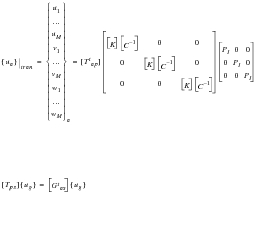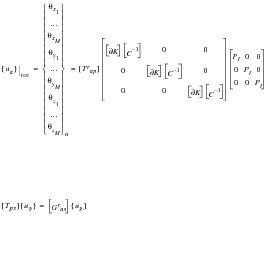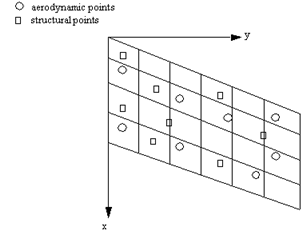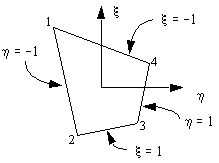XXXXXXXXXXXXXXXXXXXXXXXXXXXXXXXXXXXXXXXXXXXXXXXXXXXXXXXXXXXXXXXXXXXXXXXXXXXXXXXXXXXXXXXXXXXXXXXXXXXXXXXXXXXXXXXXXXXXXXXXXXXXXXXXXXXXXXXXXXXXXXXXXXXXXXXX''"> Theoretical Development
Infinite Plate Spline and the Linear Spline
The theoretical developments for the Infinite Plate Spline and the Linear Spline are given in some detail (in the MSC.Nastran Aeroelastic User’s Guide) and are not repeated here.
Thin Plate Spline
The thin plate spline (TPS) is a generalization of the IPS to three dimensions. The derivation is entirely analogous with the IPS with the addition of the third coordinate. The superimposed fundamental solutions (see Eq. 2-30 of Ref. 12) remain
(B‑9)

but now

. The boundary conditions at infinity now require the addition of the moment in the third axis:
(B‑10)

(B‑11)

(B‑12)

(B‑13)

(B‑14)

A solution to the general spline problem, formed by superimposing solutions of
(B‑9), is given by
(B‑15)

and Pi is the concentrated load at (xi, yi, zi)
The
N+4 unknowns

are determined from the 4 equilibrium equations
(B‑11) through
(B‑14) and the N equations
(B‑16)

(B‑17)

(B‑18)

The coefficient matrix can then be assembled that permits solution for the vector of a
iand P
i. The interpolation to any point (
x,y,z) is then achieved by evaluating
w(
x,y,z) from
(B‑15), at the desired points. This gives an overall equation relating the
M dependent aerodynamic points to a displacement pattern at the
N independent structural points:
(B‑19)
In the derivation, we have not indicated the meaning of the scalar Pi, but we can now take them to be a set of forces in one coordinate direction. In that case, provides an interpolation between forces in one direction and displacements in that direction with equilibrium preservation. We can apply that transform for each translational direction to build a three dimensional interpolant. With this observation, we now can assemble the local spline matrix that relates the aerodynamic degrees of freedom to the structural degrees of freedom for the DOF’s that are participating in the particular application of the TPS:
(B‑20)
(B‑21)
(B‑22)

and

are the three assembled
3x3 transformation matrices that relate the aerodynamic coordinate system to the spline coordinate system. Similarly,

is the assembled
3x3 transformation matrices that relate the structural displacements to the spline component directions. Just as in the 2-D case, the structural rotations are not involved in this spline formulation.
Most of the difference between this 3-D version and its 2-D counterpart is in the formation of the

matrices to account for separate treatment of each displacement component instead of a single planar interpolation surface.
Singularity Conditions: In the 2-D case, the spline interpolant is singular if the independent (structural) points are all collinear. In the 3-D case, the interpolant is singular if the independent points are all coplanar. If the TPS interpolant is found to be singular, the code automatically reverts to a 2-D interpolant with the spline plane defined by the plane of the coplanar structural grid points. In the case of a singular 2-D case, a fatal error is issued, since we do not attempt to revert to a beam spline.
Two Dimensional Finite Plate Spline
The finite plate spline (FPS) is a method that uses a mesh of elemental quadrilateral or triangular plates to compute the interpolation function. It is similar to the IPS and beam spline methods, in that the interpolant is based on structural behavior, but is different in that the equations are a discretized approximation of a finite structural component. A finite plate approximation has the advantage of being able to more closely approximate the boundary conditions at the edge of the interpolation region: boundary conditions at infinity are replaced by an FE (finite element) approximation of the independent degrees of freedom extrapolated to the plate edges. This methodology has been shown (see Ref. 2) to limit the “potato chip” effect observed in extrapolation using the IPS.
The FPS is complicated by the need to establish the virtual surface and, on that surface, a virtual mesh. For the 2D applications of Aerodynamic Panel Methods, the virtual mesh for the interpolation surface is simply the planar region defined by the CAEROi entry. A simple n x m mesh of points can be used to subdivide the region into finite elements. The geometries of these planes are such that each FE is almost certainly going to have acceptable geometry. Furthermore, since only normal forces are mapped, the structural points can be projected onto the virtual surface without any complications (noting that the aerodynamic points are on the interpolation surface).
Consider a planar trapezoidal surface that lies in a local
x-y plane and that is divided into a series of finite elements as shown in
Figure B‑1. We want to use this FE plate to interpolate between a set of
n structural points and
m aerodynamic points, which are not necessarily coincident with the N virtual mesh points.
Figure B‑1 Two Dimensional Finite Surface Spline
Consider a 4-noded quadrilateral element in which the normal displacement,

, and the rotations,

, about the
x axis and

, about the
y axis are given by:
(B‑23)

(B‑24)

and where the angles satisfy the relations
(B‑25)

The shape functions,

, are a
1x12 row matrix used to interpolate the displacement field within the element in terms of the nodal displacements,

. Experience documented in Ref. 2 suggests that a C
1continuous shape function is the preferred choice with the angular rotations given by
(B‑25) rather than by independent shape functions. For each element in the entire virtual FE mesh, a boolean connectivity matrix,

, is developed to relate the element nodal displacements to the overall FE mesh displacements:
(B‑26)

Given Equations
(B‑26) and
(B‑23), the displacement at each of the structural points and each of the aerodynamic points may be related to the virtual mesh displacements as:
(B‑27)

and
(B‑28)

and the structural point displacements and aerodynamic point displacements can be expressed as functions of the virtual FE mesh displacements:
(B‑29)

(B‑30)

Since the virtual surface described by the FE mesh is required to pass through the set of independent (structural) points, a penalty method can be used to express the equilibrium state of the virtual surface:
(B‑31)

where

represents an invertible, diagonal weighting matrix to scale the elements of

and

. Using
(B‑31) to solve for the virtual mesh displacements,

yields:
(B‑32)

and substituting into
(B‑30), the desired splining relationship can be found directly:
(B‑33)

The virtual surface stiffness properties are such that our requirements for equilibrium preservation are satisfied and virtual work principles allow us to use the transpose of
(B‑33) as the force transform. Spring attachments are available in this method by adding flexibilities to the diagonals of the matrix

in
(B‑32). Three such flexibilities are possible: k
w, k
θ and k
φ. but a single value has been used for all three in the actual implementation.
Figure B‑2 Element Coordinate System for FPS
Experience based on the implementation of Ref. 2, has shown that reasonable behavior for 2D aeroelastic applications is obtained if the virtual mesh is constructed on the plane of the CAEROi within the superscribing quadrilateral that contains all the aerodynamic points and the projected structural points. This represents an improvement over the IPS without requiring the complexity of the triangular degenerate case.
Spring Attachments and Interpolation Smoothing
Each of the splining methods lends itself to a smoothing parameter or parameters that can loosen the requirement that the interpolation “surface” pass through the structural points. This feature is useful in that, for certain selections of interpolating structural grid points, forcing the spline function to pass through all of the points causes oscillation in the interpolant (e.g., when a number of closely space grid points are attached to the spline function) or when the set of structural grid points overspecifies the behavior of the spline and causes a singularity (e.g., when more than two grids are attached to the same axial station of a beam spline or when both translations and rotations are applied at the same axial station of a beam spline).
Relaxing the equality criterion at a point can be thought of as a translational and/or torsional spring that attaches the structural point to the interpolation surface. Mathematically, this is presented in Ref. 2 and repeated here for completeness.
Each of the interpolation functions can be represented as:
(B‑34)

where

represents the spline surface deflection under a set of point loads. If the structural points are connected to the spline surface by springs, the structural displacements will differ from the spline surface deformation by the deformation of the spring. The spring deformation results in forces:
(B‑35)

where the diagonal matrix of spring stiffnesses,

. These stiffnesses are nonzero (since, if they were zero, the structural grid point would be disconnected from the spline surface and would be omitted from the set), so an inverse exists. This results in a modification to the influence coefficient matrix in
(B‑34):
(B‑36)

Thus, all that is required with any of these interpolation methods to introduce smoothing is to add a “spring flexibility” to the diagonals of the influence coefficient matrix.







